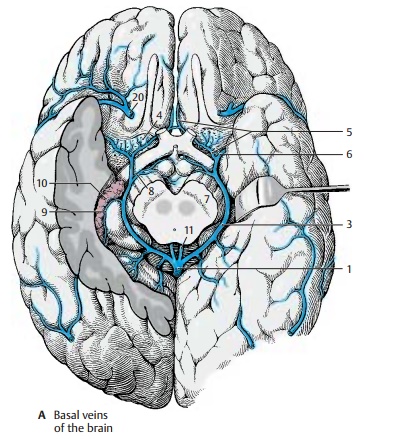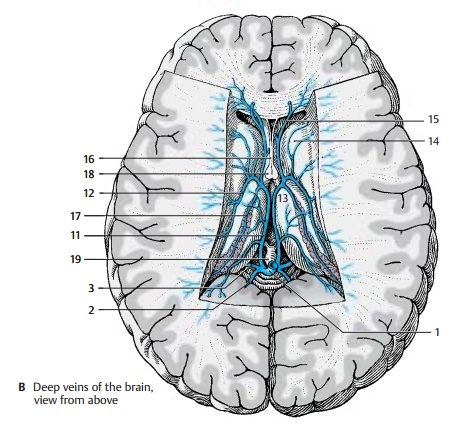Chapter: Human Nervous System and Sensory Organs : Brain's Cerebrovascular and Ventricular Systems
Deep Cerebral Veins

Deep Cerebral Veins
The deep cerebral veins collect the blood from the diencephalon, the deep structures of the hemispheres, and the deep white matter. In addition, there are thin transcerebral veins running along the fibers of the corona radi-ata from the outer white matter and from the cortex. They connect the superficial drainage areas with the deep ones. The deep cranial veins empty their blood into the great cerebral vein (great vein of Galen). Thedrainage system of the deep veins is there-fore also known as the system of the great cerebral vein.
The great cerebral vein (AB1) is a short vascular trunk formed by the confluence of four veins, namely, the two internal cerebralveins and the two basal veins. It curvesaround the splenium of the corpus callosum and empties into the straight sinus. Veins from the surface of the cerebellum and from the occipital lobe (B2) may drain into it.
The basal vein (Rosenthal’s vein) (AB3) arises at the anterior perforated substance (A4) by junction of the anterior cerebral vein and the deep middle cerebral vein.
The anterior cerebral vein (A5) receives its blood from the anterior two-thirds of the corpus callosum and the adjacent convolu-tions. It extends around the genu of the cor-pus callosum to the base of the frontal lobe. The deep middle cerebral vein (A6) arises in the insular area and receives veins from the basal parts of putamen and globus pallidus.

The basal vein crosses the optic tract and as-cends in the cisterna ambiens around the cerebral peduncle (A7) to below the splenium, where it empties into the great cerebral vein. Along its course it receives numerous venous tributaries, namely, veins from the optic chiasm and the hypo-thalamus, the interpeduncular vein (A8), the inferior choroid vein (A9) from the choroidplexus (A10) of the inferior horn, and veins from the internal segment of the globus pal-lidus and from the basal parts of the thalamus.
The internal cerebral vein (AB11) arises at the interventricular foramen (foramen of Monro) by junction of the vein of the septumpellucidum, the thalamostriate vein, and the superior choroid vein.

The thalamostriate vein (terminal vein) (B12) runs in the terminal sulcus between thalamus (B13) and caudate nucleus (B14) in rostral direction to the interventricular foramen. It receives venous tributaries from the caudate nucleus, from the adjacent white matter, and from the lateral corner of the lateral ventricle. The vein of the septumpellucidum (B15) receives venous branchesfrom the septum pellucidum (B16) and from the deep frontal white matter. The choroidvein (B17) runs with the choroid plexus tothe inferior horn. In addition to the vessels of the plexus, it receives the veins from the hippocampus and from the deep temporal white matter.
The internal cerebral vein extends from the interventricular foramen across the medial surface of the thalamus at the margin of the roof of the diencephalon to the region of the pineal gland, where it unites with the con-tralateral internal cerebral vein and the basal veins to form the great cerebral vein. Along its course it receives tributaries from the fornix (B18), from the dorsal parts of the thalamus, from the pineal gland (epiphysis) (B19) and, variably, from the deep white matter of the occipital lobe.In summary, the dorsal parts of thalamus, pallidum, and striatum drain into the inter-nal cerebral vein, while the ventral parts drain into the basal vein.
Clinical Note: Obstruction of a cerebral veincauses congestion and hemorrhage in the affected region. In case of birth trauma, rupture of the thalamostriate vein in newborns may lead to hemorrhage into the ventricles.
A20 Superficial middle cerebral vein.
Related Topics